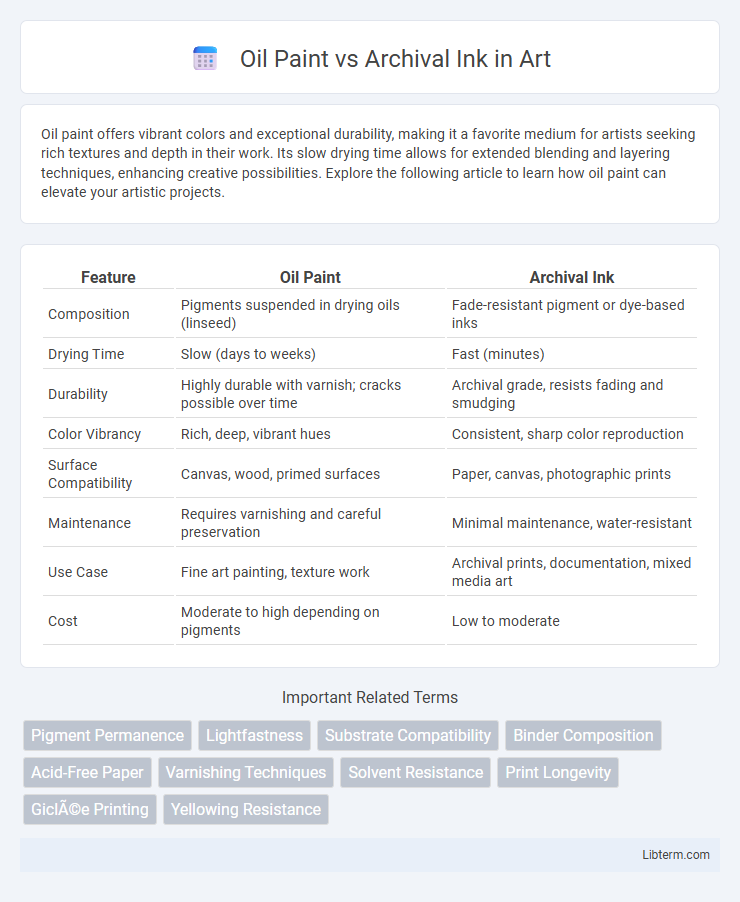Oil paint offers vibrant colors and exceptional durability, making it a favorite medium for artists seeking rich textures and depth in their work. Its slow drying time allows for extended blending and layering techniques, enhancing creative possibilities. Explore the following article to learn how oil paint can elevate your artistic projects.
Table of Comparison
| Feature | Oil Paint | Archival Ink |
|---|---|---|
| Composition | Pigments suspended in drying oils (linseed) | Fade-resistant pigment or dye-based inks |
| Drying Time | Slow (days to weeks) | Fast (minutes) |
| Durability | Highly durable with varnish; cracks possible over time | Archival grade, resists fading and smudging |
| Color Vibrancy | Rich, deep, vibrant hues | Consistent, sharp color reproduction |
| Surface Compatibility | Canvas, wood, primed surfaces | Paper, canvas, photographic prints |
| Maintenance | Requires varnishing and careful preservation | Minimal maintenance, water-resistant |
| Use Case | Fine art painting, texture work | Archival prints, documentation, mixed media art |
| Cost | Moderate to high depending on pigments | Low to moderate |
Introduction to Oil Paint and Archival Ink
Oil paint, composed of pigments suspended in drying oils such as linseed oil, offers rich texture and vibrant colors prized by artists for centuries due to its durability and blending capabilities. Archival ink, formulated to resist fading and chemical degradation, ensures long-term preservation of prints and documents with its acid-free, pigment-based composition. Both mediums serve distinct purposes: oil paint excels in traditional fine art applications, while archival ink is essential for preserving images and texts in a stable, fade-resistant format.
Composition and Material Differences
Oil paint consists of pigment particles suspended in drying oils such as linseed or walnut oil, providing rich texture and color depth, while archival ink comprises stable pigment or dye-based formulations designed for long-lasting durability on paper and other surfaces. The chemical makeup of oil paints allows for slow drying and flexibility in blending, whereas archival inks use water or solvent-based carriers engineered to resist fading, moisture, and environmental degradation over time. These fundamental composition differences influence their respective applications, with oil paint favored for canvas artwork and archival ink ideal for documents, prints, and fine art reproductions requiring permanence.
Color Vibrancy and Longevity
Oil paint offers rich color vibrancy due to its high pigmentation and slow drying time, allowing for deep, luminous hues that maintain intensity over centuries. Archival ink, while designed for permanence and resistance to fading, typically exhibits less vibrant colors because it relies on pigments and dyes that prioritize longevity over saturation. In terms of longevity, archival ink excels with exceptional fade resistance and stability on paper, whereas oil paint's durability depends on proper varnishing and environmental conditions.
Application Techniques and Tools
Oil paint requires brushes with stiff bristles or palette knives to blend and layer thick, textured strokes effectively, while archival ink is best applied with fine-tipped pens or precision brushes for detailed line work and durability. Oil painting techniques include glazing, impasto, and wet-on-wet to create depth and rich color variations, whereas archival ink excels in calligraphy, detailed illustrations, and technical drawings due to its fade-resistant, waterproof properties. Proper use of mediums like linseed oil enhances oil paint flow and drying time, whereas archival ink benefits from high-quality, acid-free paper to ensure long-lasting prints without smudging.
Drying Time and Workflow Flexibility
Oil paint typically requires 24 to 72 hours to dry to the touch, with complete curing taking weeks, impacting workflow flexibility by necessitating longer waiting periods between layers. Archival ink dries almost instantly upon application, allowing artists and printers to work efficiently with minimal downtime and immediate handling. The faster drying time of archival ink supports rapid iteration and layering, while oil paint offers richer textures but demands extended project timelines.
Surface Compatibility and Preparation
Oil paint requires a well-primed surface, such as canvas or wood treated with gesso, to ensure proper adhesion and prevent absorption, making preparation essential for longevity. Archival ink performs best on smooth, non-porous surfaces like high-quality paper, photo paper, or specially coated substrates designed to resist fading and smudging. Surface compatibility for oil paint favors textured, absorbent bases, while archival ink demands surfaces that maintain ink integrity without bleeding or degradation over time.
Archival Quality and Preservation
Archival ink offers superior permanence and resistance to fading compared to oil paint, making it ideal for long-term preservation. Unlike oil paint, which can yellow or crack over time due to its organic components, archival ink is formulated to withstand exposure to light, air, and moisture without significant degradation. This makes archival ink the preferred choice for documents, artworks, and prints requiring enduring clarity and color stability.
Artistic Styles and Effects
Oil paint offers rich texture, vibrant color blending, and slow drying times, supporting techniques like impasto and glazing that create depth and expressive brushstrokes. Archival ink provides precision, permanence, and high contrast, ideal for detailed line work, illustrations, and graphic styles requiring long-lasting clarity without fading. Artists often choose oil paint for expressive, tactile art and archival ink for sharp, clean designs with enduring archival quality.
Cost and Accessibility
Oil paint typically costs more per tube than archival ink, primarily due to the quality of pigments and the complex manufacturing process. Archival ink, designed for long-lasting prints, is generally more affordable and widely available through commercial suppliers and online retailers. Accessibility favors archival ink as it requires minimal setup and is compatible with standard printers, whereas oil paint demands specific tools and drying conditions.
Choosing the Right Medium for Your Art
Oil paint offers rich texture and vibrant colors ideal for traditional fine art, while archival ink provides precision and longevity for detailed prints and mixed media. Choosing the right medium depends on your artistic style, desired finish, and whether permanence or flexibility is paramount. Artists seeking durability and color stability often prefer archival ink, whereas those valuing depth and blendability lean toward oil paint.
Oil Paint Infographic

 libterm.com
libterm.com